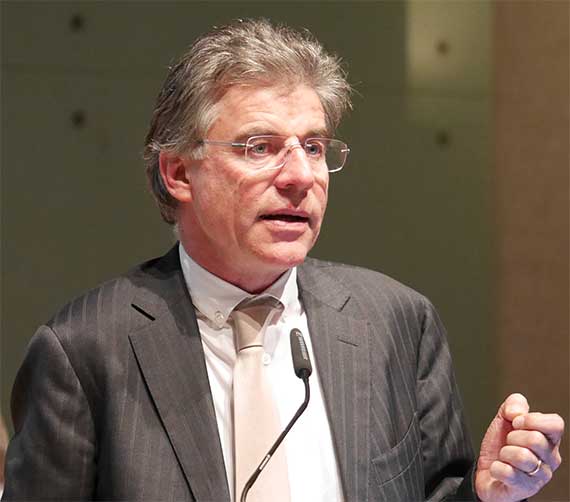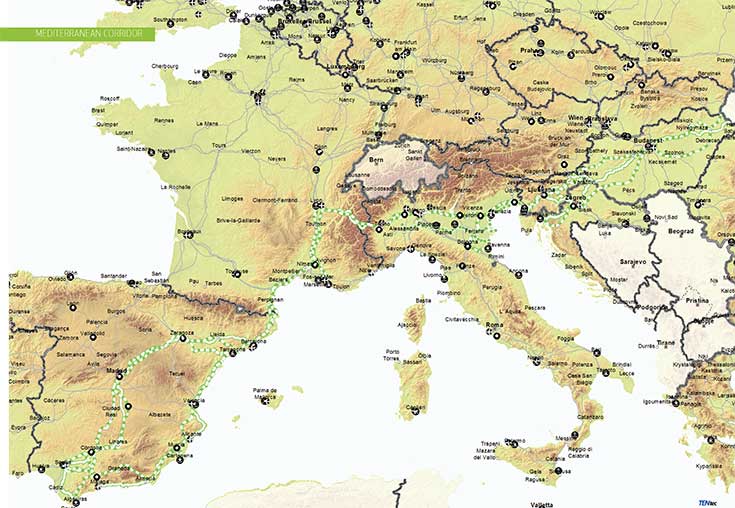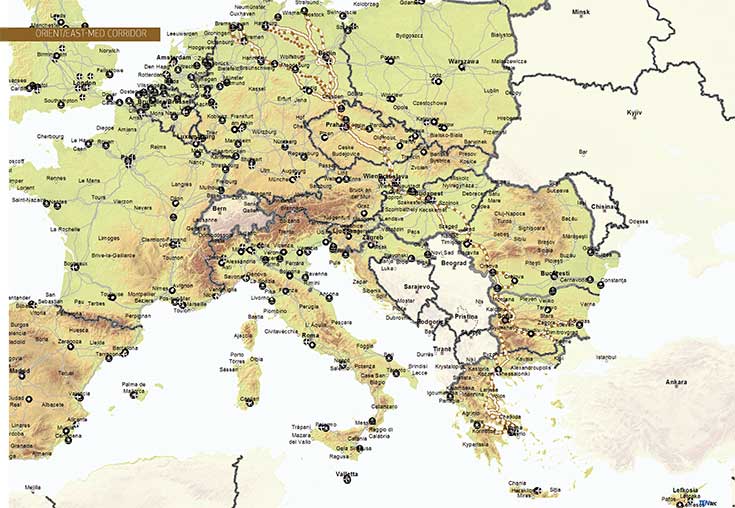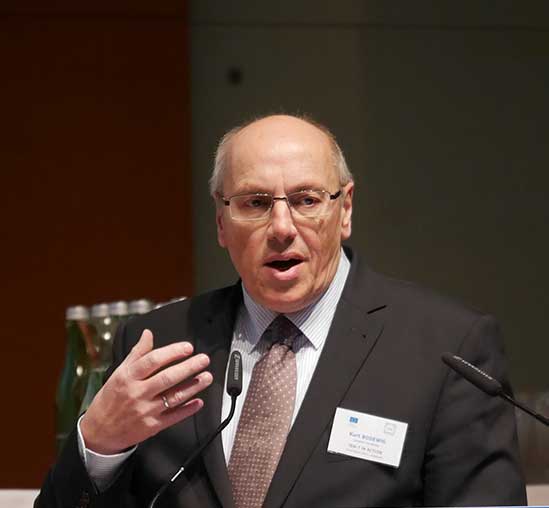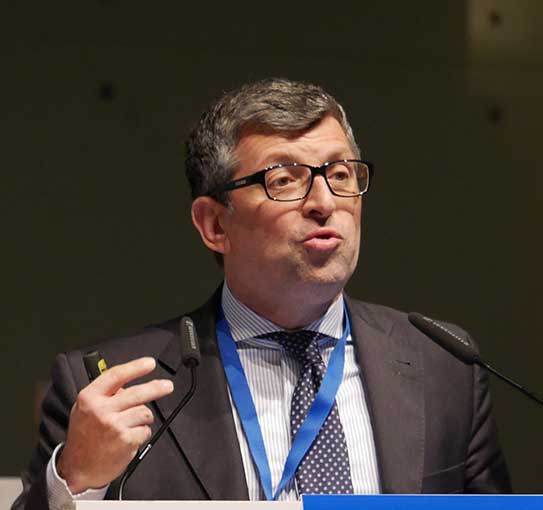Junction of the Mauls adit with the main Brenner Base running tunnels
European connectivity masterplans 9 April 2015
"In these two days of our activity report meeting, we have discussed important topics about how to design, plan, finance and build huge projects like development of the nine core network corridors to connect the North with the South of Europe," said Prof Konrad Bergmeister, CEO of the Brenner Base Tunnel project owner, BBT SE, and organizer, in cooperation with the European Commission, of the Innsbruck conference. The European Coordinators for development of the nine main corridors accepted the invitation of BBT SE and the European Commission report to the meeting, which provided up-dated information about the status quo of the trans-European Network for Transport known as TEN-T. A delegation of 450 participants paid close attention to the detailed mixture of political, technical, organisational and financial topics presented.
Prof Konrad Bergmeister welcomes more than 400 participants to the first blast ground breaking ceremony of the Ahrental contract of Brenner Base Tunnel project in Innsbruck, Austria as well as European Ministers of Transport and leading European Commission officials
One of the most important fundaments for securing a unified Europe is the investment in a modern high-performance infrastructure for land-based transportation, using railway, road and waterways, and for energy, information and communication. There is, therefore, a basic plan and a core network plan for addressing the most important bottlenecks and cross-border projects. For transportation, projects in nine corridors are set to improve east-west and north-south connections for movement of both freight and passengers. The cost of developing European infrastructure and to complete the TEN-T Core Network requires an estimated €500 billion, with €250 billion to be spent on the removing the main bottlenecks up to 2020. This is a considerable financial contribution by the European Commission to the main works on modal integration, interoperability and coordinated development of infrastructure, particularly for addressing cross-border sections and specific network bottlenecks (Fig 1). The nine Core Network Corridors comprise significant underground and tunnelling works.
1. Baltic-Adriatic Corridor
This 2,400km long corridor will provide better access to Baltic and Adriatic seaports for the economic centres in Poland, the Czech Republic, Slovakia and Austria. The main missing links are the cross-border sections and the Semmering and Koralm railway tunnels in Austria for the Alpine crossing. Construction on both projects started in April 2012 and April 2011 respectively.
2. North Sea-Baltic Corridor
The Eastern Shore of the Baltic Sea will be connected with the ports of the North Sea starting at the modern harbours on the Gulf of Finland in Helsinki and Tallinn, passing the three Baltic States and northern Poland to Warsaw. Also the traditional East-West corridor to Lodz, Poznan and Berlin, ending in the ports of the North Sea coast will be integrated. This corridor provides modern transport between Finland, the Baltic States, Poland, Germany, the Netherlands and Belgium. Cross-border operational systems for road and railway need to be modernized and developed.
3. Mediterranean Corridor
The corridor of about 3,000km long links major European areas with high-speed trains from the western Mediterranean region to the Ukrainian border with Hungary and following the coastlines of Spain and France, crossing the Alps to the east through Italy, Slovenia and Croatia. One of the well-known missing links is the new cross-border Lyon-Turin rail project between France and Italy. Two different rail gauges in Spain and different gauges in the other countries is a significant challenge for this corridor. Opening of the 621km high-speed line between Madrid and Barcelona in 2008 reduced the travelling time in this corridor from five to two hours 38 minutes and changed travelling from air and road to railway.
4. Orient/East-Mediterranean Corridor
The long northwest-southeast Orient/East-Med Corridor optimises the use of the ports and the related motorways from Central Europe with the maritime interfaces in the North, Baltic, Black and Mediterranean Seas. This corridor uses main rivers, including the Elbe, and provides a link to Cyprus. Much is needed in this corridor to build on or upgrade multimodal connections between Hungary, Bulgaria, Romania and Greece. Cross-border traffic management systems on rail and inland waterways are to be implemented on many sections.
5. Scandinavian-Mediterranean Corridor
The longest of the Core Network Corridors, this crucial axis for the European economy links the major urban centres in Germany and Italy to Scandinavia and the Mediterranean. The Brenner Base Tunnel and the Fehmarn Belt Crossing are the most important and key components to resolve cross-border bottlenecks in this corridor. The route starts at the Finnish-Russian border, passing Helsinki, Stockholm and Malmö, arriving at the European mainland to continue to the German seaports Hamburg and Rostock, following the major traffic flows in the west of Germany via Hannover to the eastern part to Berlin and Leipzig. Sections from East and West meet in Nuremberg to continue to Munich, via the Brenner Base Tunnel to Verona. In Italy the corridor continues via Bologna, Rome, Naples, the ports of Genova, Livorno, Bari and Taranto to arrive in Palermo on Sicily. The last section connects Italy with Malta via motorways of the sea. Main projects including the Öresund bridge and tunnel, road and rail fixed link between Sweden and Denmark, and the Milano-Roma-Napoli high-speed rail line are completed and in service. The new 19km long road and rail immersed tube crossing of the Fehmarn Belt between Rodby in Denmark and Puttgarden in Germany will replace the existing bottleneck ferry line is into the construction procurement stage and excavation of the Brenner Base Tunnel is advancing.
6. Rhine-Alpine Corridor
This north-south corridor is one of the busiest freight routes in Europe connecting major economic centres in western Europe from the North Sea ports of Antwerp and Rotterdam via Switzerland to the Mediterranean Basin in Genoa. The multimodal Rhine-Alpine Corridor (including the Rhine basin) provides also connections to several east-west axes. The corridor includes several missing links. These include bottlenecks in Germany and Italy that require upgrade of capacity; better interconnections needed between the Belgian and Dutch to German networks (Emmerich-Oberhausen); access routes to Swiss railway tunnels on European Union Territory need to progress (Karlsruhe-Basel and Milano (CH)-Novara). In 2019, flat trajectory for rail freight through the Alps will be possible with start of operations through the Gotthard and Ceneri Base Tunnels. The 143km long two track Betuwelijn railroad between Rotterdam harbour and the German border is in operation since 2000. The 35km Lötschberg Base Tunnel railway, the world´s longest passenger and freight land tunnel, of the AlpTransit Project in Switzerland is in service with the 57km long Gotthard Base Tunnel of the AlpTransit Project planned start of operation in 2017.
7. Atlantic Corridor
For the continuity of the Lisbon, Madrid, Paris and Strasbourg/Mannheim network, this diagonal corridor links the high speed and parallel conventional rail lines of the Iberian Peninsula with France and Germany. The aim of this corridor is to change the freight transport from road and air to railway with connections to the different ports crucial. Main missing links for both road and railway are between Lisboa and Madrid, Porto-Valladolid, San Sebastian-Bordeaux. In June 2011 the Tours-Bordeaux high-speed rail line started operation as a public private partnership project and with financial support from the help of the European Investment Bank. This was the first high speed rail line PPP signed in France.
8. North Sea-Mediterranean Corridor
The multimodal North Sea-Mediterranean Corridor stretches from Ireland, North of UK, via the Netherlands , Belgium and Luxembourg to the Mediterranean Sea in Southern France and offers better services for freight and passengers. This corridor incorporates several waterways including the Seine-Scheldt, Rhine-Rhone river connection with the Canal Seine-Escaut. In Ireland and UK, rail connections are missing between Belfast and Dublin or Dublin and Cork, which are being developed by the DART project. The Channel Tunnel is important part of this cross-border connection, converting many travelled kilometres from air and road to rail. In 2010, this corridor became Europe´s first fully operational cross-border high-speed passenger rail service between Belgium, France, Germany, the Netherlands and the UK (London-Brussels-Amsterdam-Cologne-Paris). Also under operation in the corridor are high-speed lines between Lyon and eastern France, Switzerland and Germany. A second phase of development, with 50km of construction started in 2014/2015.
9. Rhine-Danube Corridor
This main east-west corridor is linking all continental European countries along the Main and Danube Rivers to the Black Sea by improving high-speed rail and inland waterway interconnections from France and Germany to Austria, the Czech Republic, Slovakia, Hungary, Romania and Bulgaria. Main missing links are the cross-border rail network interconnections between Germany and its neighbours France, Austria and the Czech Republic. Also needing to be removed are bottlenecks between Austria and Slovakia, and within Slovakia, Hungary, Romania and Bulgaria. Between the north-western European Basins and the south-eastern Black Sea, the main inland connections between the Rhine, Main and the Danube Rivers represent the backbone of the inland waterways. Work remains to be completed on the waterways in the eastern regions while several rail sections have been upgraded in Austria and France.
Modern, high-performance infrastructure for Europe
In her keynote speech, Violeta Bulc, European Commissioner for Transport and appointed patron of the Ahrental Tunnel contract of the Brenner Base Tunnel project in Austria, stated: "A fully functioning single European transport area depends on modern infrastructure for transport, energy as well as information and communication technologies." Connecting all member states of Europe means to connect daily life of all Europeans. This can only work if different local markets and structures are linked to each other.

Violeta Bulc, European Commissioner for Transport, holds a statue of Santa Barbara, the patron saint of tunnellers, and after being named the patron of the Ahrental Main Tunnel contract of the Brenner Base Tunnel project in Austria
To solve the demand for connecting infrastructure, the nine corridors, as part of the TEN-T multimodal Core Network, are built on the decisions of the European Transport Policies of the past and also of tomorrow. "The seminar on cross-border infrastructure projects stimulated discussion among the European Commission, represantatives of the member states, project promoters and the civil society. This event in Innsbruck fulfilled my expectations of an activity report towards successful development."
The new TEN-T (Trans-European Network for Transport) has been in effect since 2014 and among the major cross-border projects for the coming 10 years are the Brenner and the Lyon-Turin railway base tunnels through the Alps and the Fehmarn rail-and-road crossing in the Baltic Sea. These and other main cross-border projects require enormous financial, political and administrative commitment. Preparatory activities such as route alignment, environmental and geological assessments, decision-making on organizational set-ups and financing, permitting and contracting procedures and more, have taken considerable cost and effort to date. Development of these projects have now reached a point of no return and the potential benefits, as TEN-T links, elevate them to crucial investment status. While these projects stand out for their role as critical TEN-T success factors, the challenges associated with each differ depending, for example, on the project’s geographical and technical features, on political, legal and administrative processes and on structural choices made. In front of this background, the March conference on Cross Alpine Corridors of the European Commission in cooperation with BBT SE was an important milestone.
Denoting its significance, several political celebrities from the participating European countries attended the conference. Ministers of Transport for seven European Union member nations and officials of the European Commission also attended the March 19 ground breaking ceremony of the Ahrental Tunnel contract in Innsbruck as an historical start of the largest construction lot of the Brenner Base Tunnel on Austrian territory.
On March 20, 2015 the BrennerCongress started with keynotes by the Transport Ministers of Austria, Germany, Italy, France, Slovenia, Switzerland and Liechtenstein. These were followed by presentations by four European Coordinators in summing up the results of the discussions about the four key Congress topics of Project Structure, Project Financing, Procurement and Legal Procedure and Communication.
Project Structures
"We shared our experiences with developing projects, learning by the exchange of experiences," said Pat Cox, European Coordinator of the Scandinavian-Mediterranean Corridor. He described four key points to understand as a conclusion. There is agreed added value of specific and dedicated cross-border structures. Managerial and operational autonomy, with accountability and within agreed parameters, is important for most project structures. An overall fusion of interest and capacity is needed, creating unity in diversity. "It is not possible to show a perfect model of how to progress, but we can learn from each other."
Project Financing
"The need to involve private financing for our projects is becoming more and more important,” explained Carlo Secc, European Coordinator of the Atlantic Corridor. “In our group we discussed, how it is possible to optimise financing in the different core projects," To optimise scarce public resources and self financing - which is a strong special purpose vehicle - were the most agreed solutions in the different projects. The group also explored the possibilities of exploiting all financial resources, including cross-financing and polluter pays schemes; identification of suitable project components; total life-cycle approaches and clarification of legal frameworks to attract investors.
Procurement and Legal Procedures
"The problems are very clear, but the solutions are not," stated Kurt Bodewig, European Coordinator of the Baltic Adriatic Corridor, reporting on the topic of procurement. "Exchange of experience with EU procurement guidelines for cross-border projects was a main part of the discussions." Measures to facilitate procurement were summarised as simplifying procurement rules, standardisation of procurement processes, establishment of a legal seat independent from the participating countries, definitive choice of procurement language and, last but not least, acceleration of the processes by increase efficiency.
Communication
Mathieu Grosch, European Coordinator of the Orient/East–Med Corridor, presented the results of the discussions about communication. All involved agreed that communication is required for all nine corridors to create a sense of ownership, trust and knowledge, to participate and share messages at all levels and all directions, exchange through appropriate governance, involvement of the local population, exchange of best practices via tunnel job site visits and open days, and a strong communication of the benefits of all the projects to Europe as a whole.
Future of European Railways
To open the technical sessions of the Congress, Christian Kern, CEO ÖBB and Chairman Community of European Railway and Infrastructure Companies, posed a question: With view on the €700 billion investment in future rail projects in Austria, and with several possibilities of doing so, how to invest this money prudently and who could and should undertake these investments. "We are at a turning point of structural change and economic development and we must manage investments wisely.” Maurizio Gentile, CEO of Rete Ferroviaria Italiana, tried to answer the question by citing the Brenner Base Tunnel development by Italy and Austria as an example of how to solve different problems in the field of technical and normative harmonisation.
Brenner Base Tunnel: Core Element of the Scandinavian - Mediterranean Corridor
Dott. Ing. Raffaele Zurlo, CEO BBT SE, gave an actual overview of the state of works at the Brenner Base Tunnel. On the largest construction lot awarded so far, the €380 million Tulfes-Pfons lot, excavation has been underway since September 2014. As one of the four tunnel sections in the lot, the Ahrental Access Tunnel reached its junction with the alignment of the main running tunnels after only three months of drill+blast excavation. Works for creating the logistics to support excavation of the first kilometre of the main tunnel and the connecting tunnels from the Innsbruck bypass of the main tunnel are also progressing well.
To date some 36km of tunnelling associated with the mega-base line tunnel project are excavated and the ground-breaking ceremony on Thursday, March 19, 2015, in Innsbruck and as part of the Congress, excavation began on the main running tunnel tubes in Austria. In Austria, three more excavation fronts will begin and in November 2015, a TBM will be introduced to work from Ahrental towards the Brenner pass and drive a further 15km stretch of the exploratory tunnel.
In Italy more than 3.6km of the two main running tunnels have been excavated. On the Isarco underpass construction lot work is under high pressure. This construction lot, worth €300 million, covers the southernmost part of the tunnel project and close to the railway station in Fortezza.
As further use, the Mules-Brenner section is about to go into tender. This lot includes the exploratory tunnel north of the Periadriatic seam to the Brenner, both main tunnels from the Isarco River underpass to the Brenner and the Campo di Trens emergency stop. The estimated €1.8 billion contract for excavation of main running tunnels from Ahrental in Austria will be tendered in 2016. This lot also includes construction of the stretch of the exploratory tunnel from Steinach am Brenner to the border and the emergency stop at St. Jodok.
Operations of the longest underground railway connection in the world are set to start at the end of 2026 and will cut rail travel times between Innsbruck and Bolzano from 2 hours to less than 1 hour.

Latest schematic of the 55km long Brenner Base Tunnel from the Innsbruck North Portal in Austria on the lower left to the Aicha South Portal in Italy in the upper right
Innovations and skills for building mega infrastructures
After presentations of other mega cross-border projects including the Lyon-Turin Tunnel Eralpine, the Rail Baltic, the Fehmarn Belt Link, and the Seine-Escaut and Gent-Terneuzen projects, a set of technical topics were presented.
Prof Peter Mark of Ruhr-University Bochum, explained the use of satellite-based radar to monitor vertical deformations caused by tunnelling works and demonstrating experiences of the system as applied on the intra-urban Wehrhahn-Linie tunnelling project in Düsseldorf, Germany. Dott Ing Remo Grandori of SELI presented an overview about the latest innovations in tunnel boring machines. He recommended an exploratory tunnel in advance of long and large diameter main tunnels heading into unforeseen geological conditions.
Prof Robert Galler of Montanuniversität Leoben in Austria, described how to use analyses techniques developed in DRAGON (Development of Resource-efficient and Advanced Underground Technologies) to recognize the value of materials at the tunnel face which allows them to be cycled into other uses directly from the excavated tunnel. Prof. Konrad Bergmeister, CEO BBT SE of Austria explained a novel life-cycle design for new infrastructure and for lifetime extension of existing structures. He presented a procedure for managing this in cooperation with all project partners.
References
- Prelude to building Brenner Baseline – TunnelTalk, March 2009
- Brenner Base Tunnel – let the works begin! – TunnelTalk, April 2011
- Brenner pushes ahead with new contracts – TunnelTalk, July 2014
- Brenner Base Tunnel river undercrossing award – TunnelTalk, November 2014
- Ground preparation at Semmering Base Tunnel – TunnelTalk, February 2013
- First TBM launched for Koralm rail tunnel – TunnelTalk, February 2013
- Progressing the Lyon-Turin base rail link – TunnelTalk, August 2013
- Fehmarn costs adjusted as awards awaited – TunnelTalk, January 2015
- Channel Tunnel 20 years on – TunnelTalk, December 2010
- Channel Tunnel fire prompts SAFE system review – TunnelTalk, March 2015
- Australia suffers toll concession failures – TunnelTalk, July 2013
- Ireland drops €5.6 billion metro projects – TunnelTalk, December 2011
- Santa Barbara watches over tunnellers – Discussion Forum
|
|
|
|
|
Add your comment
- Thank you for taking the time to share your thoughts and comments. You share in the wider tunnelling community, so please keep your comments smart and civil. Don't attack other readers personally, and keep your language professional.


